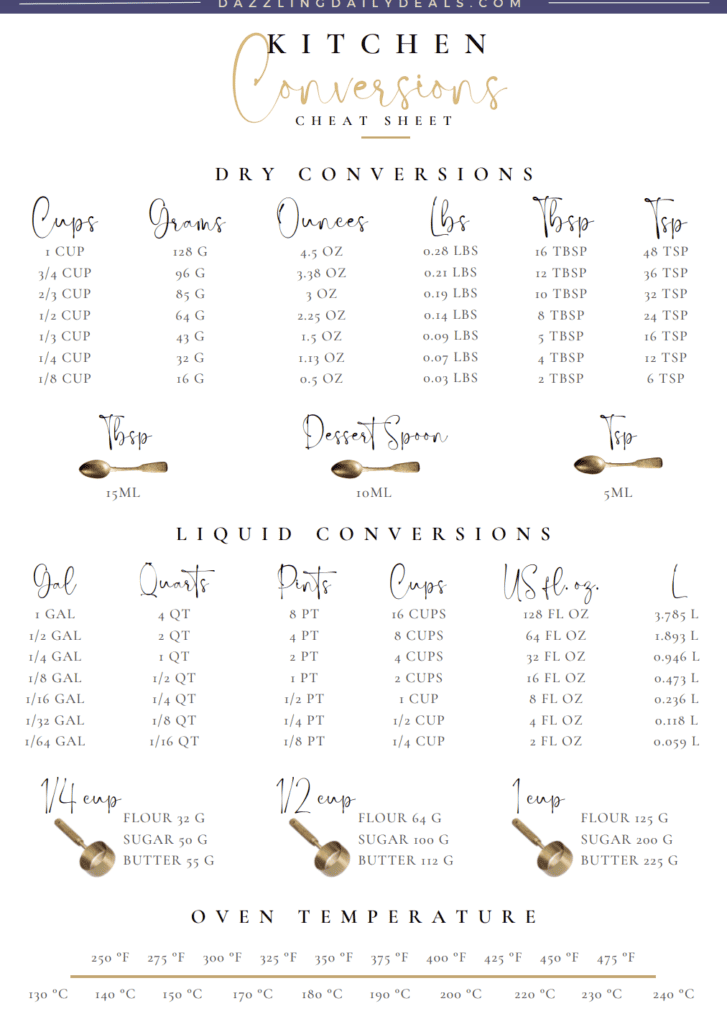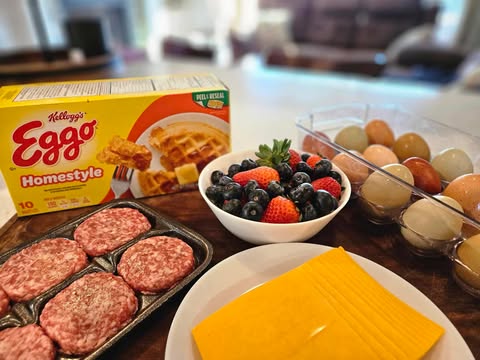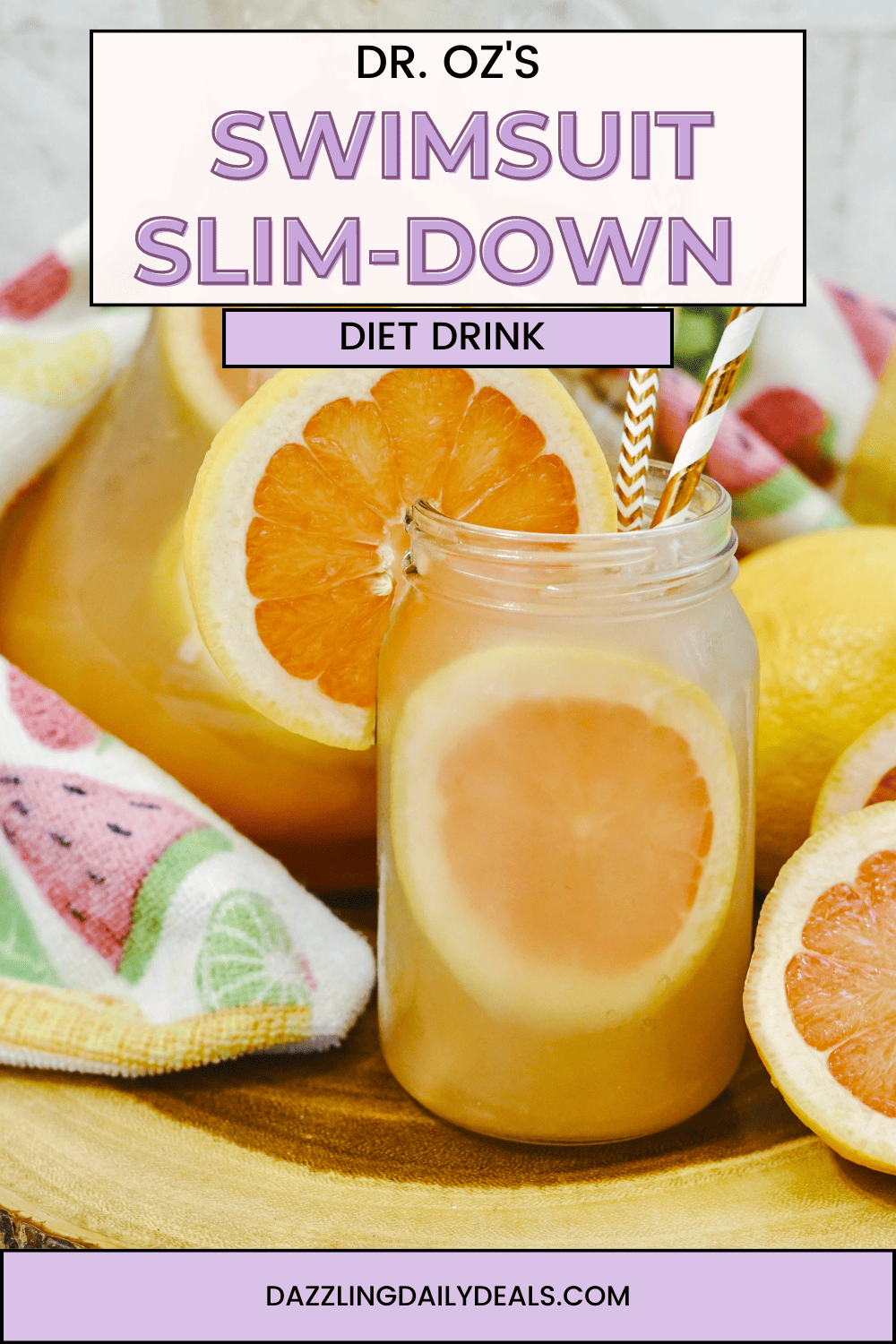This post may earn affiliate income from links and/or review products to help support this site from the companies .
Baking is both a science and an art, and accurate measurements are key to achieving delicious and consistent results. While many recipes provide measurements in cups, it’s important to know the equivalent conversions for other common units of measurement. In this post, we’ll cover essential baking conversions for cups, pints, quarts, gallons, measuring spoons, and ounces. Whether you’re a novice or an experienced home chef, this quick reference guide will help you navigate the world of baking measurements with confidence.
DOWNLOAD YOUR PDF HERE
Cup Conversions:
Cups are one of the most commonly used units in baking. They provide a convenient and easily recognizable measurement for many ingredients.
How many tablespoons in a cup
1 cup = 16 tablespoons
How many tablespoons in half a cup
1/2 cup = 8 tablespoons
How many tablespoons in a quarter cup
1/4 cup = 4 tablespoons
How many teaspoons in a cup
1 cup = 48 teaspoons
How many ounces in a cup
1 cup = 8 fluid ounces
How many liters are in a cup
1 cup = 237 milliliters
Pint Conversions:
Pints are often used to measure liquid ingredients. Here’s how pints convert to other units of measurement. How
How many cups in a pint
1 pint = 2 cups
How many tablespoons in a pint
1 pint = 32 tablespoons
How many teaspoons in a pint
1 pint = 96 teaspoons
How many ounces in a pint
1 pint = 16 fluid ounces
How many tablespoons in a pint
1 pint = 32 tablespoons
How many teaspoons in a pint
1 pint = 96 teaspoons
How many ml in a pint
1 pint = 473 milliliters
Quart Conversions:
Quarts are larger units used for measuring both liquid and dry ingredients. The conversions for quarts are as follows:
How many cups in a quart
1 quart = 4 cups
How many pints in a quart
1 quart = 2 pints
How many tablespoons in a quart
1 quart = 64 tablespoons
How many teaspoons in a quart
1 quart = 192 teaspoons
How many ounces in a quart
1 quart = 32 fluid ounces
Gallon Conversions:
Gallons are commonly used for bulk quantities of ingredients. Here are the conversions for gallons
How many cups in a gallon
1 gallon = 16 cups
How many pints in a gallon
1 gallon = 8 pints
How many quarts in a gallon
1 gallon = 4 quarts
How many liters in a gallon
1 gallon = 3.78541 liters
How many ounces in a gallon
1 gallon = 128 fluid ounces
Measuring Spoon Conversions:
Measuring spoons are essential for precise measurements of smaller quantities. Here are the conversions for common measuring spoon sizes
How many tablespoons in 1/4 cup
4 tablespoons – 1/4 cup
How many tablespoons in 1/3 cup
5.333 tablespoons = 1/3 cup
How many tablespoons in 1/2 cup
8 tablespoon – 1/2 cup
How many teaspoons in a tablespoon
1 tablespoon = 3 teaspoons
How many ounces in a tablespoon
1 tablespoon = 0.5 fluid ounces
How many ml in a tablespoon
1 tablespoon = 14.8 milliliters
How many teaspoons in a tablespoon
1 teaspoon = 0.33 tablespoons
How many ounces in a teaspoon
1 teaspoon = 0.17 fluid ounces
How many ml in a teaspoon
1 teaspoon = 4.9 milliliters
1 8 cup how many tablespoons
2 tablespoons = 1/8 cup
Ounce Conversions:
Ounces are commonly used for both liquid and dry ingredients. Here are some basic ounce conversions:
How many tablespoons in an ounce
1 ounce = 2 tablespoons
How many teaspoons in an ounce
1 ounce = 6 teaspoons
How many cups in an ounce
1 ounce = 0.125 cups
How many ounces in a teaspoon
1 ounce = 0.166667 teaspoons
how many ounces in a tablespoon
1 ounce = 2 tablespoons
How many liters in an ounce
1 ounce = 0.03 liters
Why do we use these measuring methods?
Q: Why is it important to use precise measurements in baking?
A: Baking is a delicate balance of ingredients and chemical reactions. Precise measurements ensure that the right proportions of ingredients are used, resulting in consistent and delicious outcomes. Without accurate measurements, the texture, taste, and overall quality of your baked goods may be compromised.
Q: Why are cups commonly used in baking recipes?
A: Cups are a versatile unit of measurement that allow for easy and convenient scaling of recipes. Many home chefs have measuring cups readily available in their kitchens, making them a popular choice. Cups also provide a rough estimation of ingredient quantities, which is often sufficient for certain recipes.
Q: When should I use more precise measurements, such as fluid ounces or grams?
A: While cups are useful for many baking recipes, some delicate recipes require more precise measurements. Fluid ounces and grams provide a more accurate measurement, particularly for liquids and ingredients that need to be precisely measured by weight. Recipes involving intricate pastries, cakes, or delicate sauces often benefit from using fluid ounces or grams to achieve consistent results.
Q: Can I substitute one measurement for another?
A: While it’s generally best to follow the recipe as closely as possible, small substitutions can often be made without drastically affecting the outcome. However, be cautious when substituting liquid and dry ingredients, as their volumes can vary significantly.
Q: Can I convert weight measurements to volume measurements?
A: Converting weight measurements to volume measurements can be challenging since different ingredients have different densities. Weight measurements are more precise, especially when it comes to ingredients like flour or sugar, where the density can vary. It’s best to use a kitchen scale for accurate results when weight measurements are specified.
Q: How can I convert metric measurements to imperial measurements?
A: To convert metric measurements (e.g., milliliters, grams) to imperial measurements (e.g., cups, ounces), you can use online conversion calculators or reference tables. These tools will help you convert between the two systems of measurement accurately.
Q: What if my recipe doesn’t specify a unit of measurement?
A: If a recipe doesn’t specify a unit of measurement, it’s usually safe to assume that it refers to the standard US measurement system (cups, tablespoons, teaspoons, etc.). However, if you’re unsure, it’s best to refer to a reliable source or reach out to the recipe author for clarification.
Q: Are there any measurement methods specific to baking?
A: Bakers often use weight measurements (such as grams or ounces) for more precise results, especially in professional or advanced baking. Weight measurements eliminate the variability that can arise from the density and packing of ingredients when using volume measurements.
Tips for Accurate Measurement
Accurate measurement is key to successful baking. Here are a few tips to ensure precise measurements:
- Use the correct measuring tools: Invest in a set of reliable measuring cups and spoons made of sturdy materials. This will help you achieve consistent results and avoid discrepancies.
- Level off dry ingredients: When measuring dry ingredients such as flour, sugar, or cocoa powder, use a straight-edged utensil (like the back of a knife) to level off the excess. This ensures you’re using the exact amount specified in the recipe.
- Spoon and level for flour: For flour specifically, it’s best to spoon it into the measuring cup and level it off. Scooping the cup directly into the flour can result in densely packed cups, leading to dry and heavy baked goods.
- Learn the proper technique for measuring liquids: When measuring liquids, place the measuring cup on a flat surface and pour the liquid in while keeping it at eye level. This ensures accuracy and prevents spillage.
- Convert ingredients consistently: When adjusting a recipe or converting between units of measurement, make sure to convert all ingredients consistently. This ensures the right balance of flavors and textures in your baked goods.
In the world of baking. Understanding and utilizing the various conversions for cups, pints, quarts, gallons, measuring spoons, and ounces will not only help you follow recipes accurately but also allow you to modify and adapt recipes to suit your preferences.
By having a quick reference guide like this at your fingertips, you can confidently navigate your way through any baking adventure. Whether you’re measuring out flour for a fluffy cake or carefully portioning out vanilla extract for the perfect cookie dough, these conversions will serve as your trusty companions in the kitchen.
Remember, baking is both a science and an art. While precise measurements are important, don’t be afraid to experiment and make adjustments to suit your taste. The more you practice, the more intuitive your baking skills will become.
So, armed with this knowledge of baking conversions, go forth and create culinary delights that will impress your family and friends. May your cakes rise, your cookies be perfectly chewy, and your pastries be flaky and golden. Happy baking!



